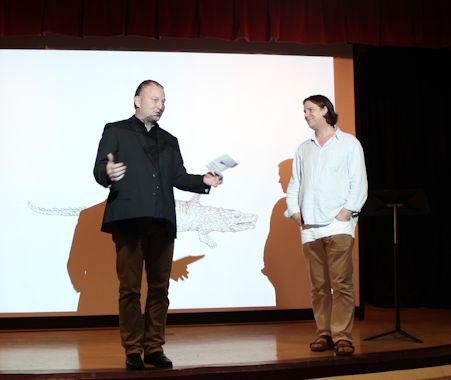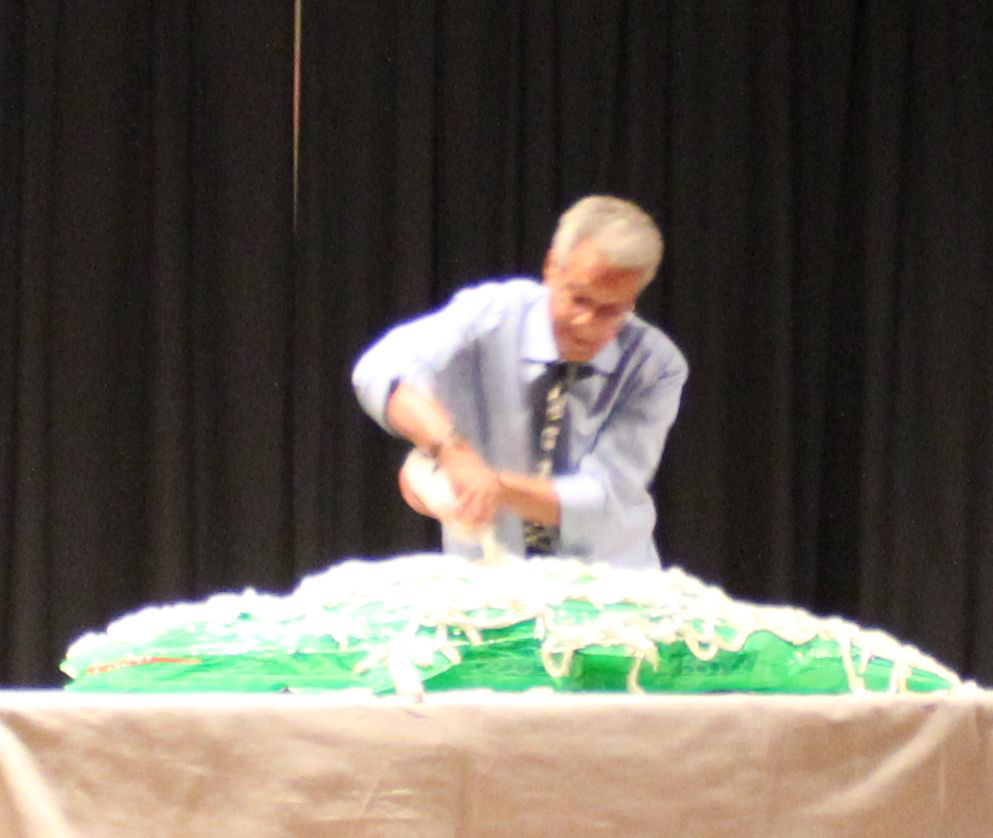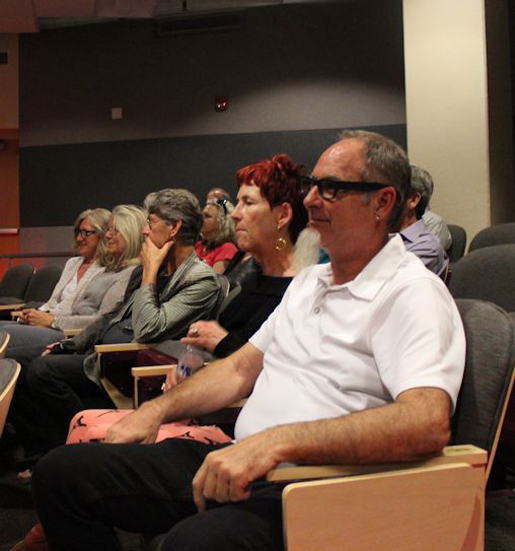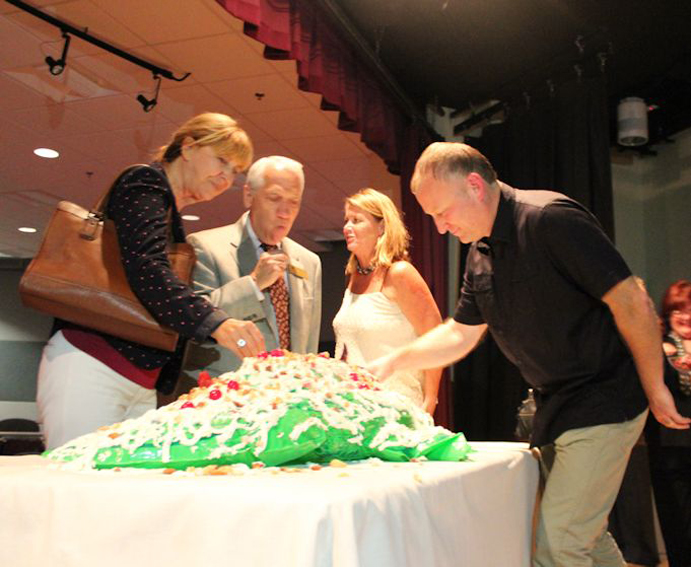« Features
Making sense of Ben Patterson’s ‘Fluxus in the Swamp’ performance
By Tom Hall
To the Fluxus newbie, what transpired in the Rush Auditorium at Florida Southwestern State College last Tuesday evening may have seemed like unadulterated nonsense masquerading as art. Fluxus pioneer Ben Patterson certainly did everything within his power to foster that belief from the outset of his lecture and performances. But Fluxus in the Swamp served as a delectable object lesson in the principles espoused by Patterson and the diverse group of visual artists, musicians, writers and performers who came to be associated with the movement that celebrated its silver anniversary in September of 2011.
It all started with a “simple” opera that contained “no profound messages, no great emotions, no heroes or heroines,” and “intellectually … very little” of anything else. In fact, the musical instruments consisted of little more than rubber alligators struck against crushed aluminum cans. Then after admitting that if you can define it, it’s probably not Fluxus anyway, Patterson shared a number of anecdotes about the points that he and his colleagues were trying to make. But it wasn’t long before Patterson cut to the chase, maintaining that “the best way to learn about Fluxus is to experience it.” With that said, led those assembled in the Rush Auditorium through an illustrative action poem.
“Think of the number 6,” he instructed. “Bark like a dog. Think of the number 6 twice. Stand. Don’t think of the number 6. Sit down. Think of the number 6. Bark again.” And for all intents and purposes, the audience did as told.
Meanwhile, stage left sat four plastic bottles filled with water reprising Yoko Ono’s Invitation to Participate in a Water Event, in which she invited people to bring containers to her 1971 exhibition, filled the vessels with water, and displayed them in the show as collaborative works of art.
Patterson then launched into a brand new Fluxus score, one he prepared especially for Fort Myers. “Cover shapely female with whipped cream. Lick. Nuts and cherries optional,” he said before disappearing behind the movie screen that dominated the center of the stage, leaving the tittering audience to indulge their imaginations about what would happen next.
After several minutes, the house lights dimmed and the screen disappeared, revealing an empty black-bottomed banquet table. Patterson (undoubtedly with tongue planted firmly in cheek) pulled out a bicycle pump, attached it to a plastic alligator and began rhythmically inflating the salamander green blow-up pool toy in tune with excerpts from Tristan and Isolde by Wagner with Karajan and Jessye Norman on Deutsche Gramophone playing on the Rush Auditorium sound system. Once the shapely female (”you can tell from the fingernails”) had assumed her full fecundity on the crisp white tablecloth in front of him, Patterson unceremoniously (but with some degree of theatrical flair) covered the gator with three cans of whipped cream, cherries and chopped nuts before inviting the audience on stage to dip a salsa chip into the sumptuous feast he had prepared for the occasion.
Making Sense of It All
Patterson would beam with pride at the allegation that Fluxus in the Swamp was not real art. After all, he and his fellow Fluxus artists characterized what they did as anti-art. They flatly rejected the notion that museums and art institutions should serve as fine art’s gatekeepers, with the correlative authority, whether actual or perceived, to determine what constitutes art and who qualifies for recognition as artists. They did not just dismiss the elitist world of “high art.” They mocked it. And in keeping with the social climate of the 1960s, they sought out ways in which to bring art to the masses just as Patterson brought art to the Rush Auditorium crowd last Tuesday night.
Events, Happenings and Performance Scores Involved Simple Ideas and Objects
Beginning around 1961, Fluxus artists like Patterson, Joseph Beuys, Yoko Ono and Nam June Paik began creating events, happenings and performances in the United States, Europe and Japan. The “scores” for these events, happenings and performances typically involved simple ideas (like “think of the number 6, bark, stand, don’t think of the number 6″) that could be performed by anyone at any time in any place.
As Patterson noted during the lecture portion of the evening, some scores utilized simple objects you could find anywhere. For example, George Brecht’s Water Yam (1972) used printed cards, which were packaged into plastic boxes. For Fluxus in the Swamp, Patterson used a blow up pool toy that he found in a Fort Myers Beach gift shop. Anything at all can be art. Fluxus artists pioneered the concept popularized by Warhol, Pollock and Damien Hirst that art is whatever an artist says it is.
Playfulness and Humor Key Component
Playfulness and humor have always been a key component of a Fluxus score, and Patterson has a long tradition of using musical instruments and toys in his pieces. One of his most visually arresting works is Two for Violins (After One for Violin by Nam June Paik). The work is composed of two shattered violins and a wooden backing, and it balances exacting arrangement with chaotic shattering. “The work refers to Fluxus visionary Nam June Paik, whom many consider the first video artist,” writes art critic Joseph Campana in culturemap Houston. Paik’s 1962 performance One for Violin consisted of a performer smashing a violin on a podium. “Patterson pays homage while sculpting elegance from the violence of Paik’s iconoclasm.”
During the lecture, of course, Patterson referenced the most famous (or perhaps infamous) example of humor and playfulness gone awry, namely the time when he, George Maciunas, Dick Higgins, Wolf Vostell and Emmett Williams dismantled a piano with saws, hammers and sledgehammers while performing Philip Corner’s Piano Activities at Fluxus Internationale Festspiele Neuester Musik in Weisbaden in 1962. (Photograph by Hartmut, right.) “We weren’t very popular in Wiesbaden,” Patterson quipped last Tuesday night, although he noted that the town went overboard in commemorating Fluxus’ 50th anniversary “with every museum and art institution doing something Fluxus related.”
Audience Participation
Fluxus events almost always included audience participation like the Fluxus in the Swamp chips-and-whipped-cream processional. For example, in the 1970 Fluxfest presentation of John Lennon and Yoko Ono, Fluxus father George Maciunas made paper masks of John and Yoko for the audience to wear in order to shift the role of the viewer from observer to performer. The use of the audience as the focus of the piece was a logical extension of his idea that, “anything can substitute for art and anyone can do it…the value of art-amusement must be lowered by making it unlimited, mass-produced, obtainable by all and eventually produced by all.”
Rejection of Commodity Status and Monetization of Art
Fluxus artists reacted against the commodity status of art, its commercialization in the gallery system, and its static presentation in traditional institutions. Nevertheless, sometimes a document or artifact from a Fluxus event became a work of art, a material presence that referred to an absent action or previous performance. For example, Alison Knowles’ Journal of the Identical Lunch (1971) documents her ritual noontime performances at a New York diner with various artists and friends, and Dick Higgins’ ongoing series, The Thousand Symphonies, consisted of musical scores he composed with bullet holes and paint on sheet music. Both now have value in the secondary art market. It remains to be seen whether Patterson’s plastic alligator becomes an artifact that takes on a value far beyond the few dollars he paid for the toy because it now relates back to and therefor represents his seminal Fluxus work, Licking Piece.
Intermedia
Just as Patterson performed Fluxus in the Swamp to classical music, other Fluxus performers regularly incorporated musical compositions, concrete poetry, visual art, and writing, thereby embodying Higgins’ idea of “intermedia”- a dialogue between two or more media to create a third, entirely new art form. Fluxus performances also incorporated actions and objects, artists and non-artists, art and everyday life in an attempt to find something “significant in the insignificant.” The influence of this highly experimental, spontaneous, often humorous form of performance art prevailed throughout the 1970s and is being rediscovered by a younger generation of artists working today.
Alternative View of Music and Musicality
Because of his classical music training and experience, Patterson made his most significant contributions to Fluxus by offering alternative views of music and musicality. After a brief encounter with John Cage in 1960, Patterson began experimenting with new musical compositions and instruments. For example, in his iconic Paper Piece (which was barely mentioned during Fluxus in the Swamp), Patterson created a symphony of sounds produced by performers waving, shaking, ripping, wadding and crumpling newspaper and magazine pages. At Fluxus in the Swamp, by contrast, Patterson’s “spectacle of music” was an operetta in which three student volunteer performers created the accompaniment by rhythmically beating and scraping toy rubber alligators on, over and across semi-crushed aluminum cans.
Fluxus and Yoko Ono
During the Q&A, Patterson was asked by Bob Rauschenberg Director Jade Dellinger to discuss Yoko Ono’s contribution to Fluxus. Patterson recalled that Fluxus father George Maciunas often asked her to help him launch various projects. One of those was the first International Festival of New Music which debuted in 1961 at the Staatsmuseum in Wiesbaden, Germany. Widely regarded today as the first official Fluxus event, it featured an all-star cast of Fluxus luminaries including John Cage, Philip Corner, Dick Higgins, Alison Knowles, George Maciunas, Nam June Paik, David Tudor, Emmett Williams, among others. Patterson not only co-organized the event, he is one of its last surviving participants.
Although Patterson did not specifically address it, Yoko’s Play It By Trust (pictured right from her recent Rauschenberg Gallery solo show Yoko Ono Imagine Peace) has deep Fluxus roots, tracing itself back to Robert Filliou’s Optimistic Box #3, which featured a fold-up chess board and identically-looking pieces distinguishable only by the sounds they made when shaken. Ono employed Play It By Trust to make a political statement, using all-white pieces to illustrate how, in politics and war, absurdity and chance replace strategy and reason thereby echoing the central Fluxus idea that art (or life) is a game in which the artist reconfigures the rules.
Like Patterson’s own scores, Yoko’s Play It By Trust, Wish Tree, Map Piece and other works belie scores that can be carried out and performed by anyone, any time and any place - like perhaps her most famous pre-Lennon score, Breath Piece, in which she printed the word “Breathe” on the wall punctuated with a period to evoke Marcel Duchamp’s claim that he had given up art to become a “respirator” because, as he said, “each breath is a work which is inscribed nowhere.”
Fluxus Died with George Maciunas …. Not
The New York Times maintained on the 50th anniversary of the International Festival of New Music at the Staatsmuseum in Wiesbaden, Germany that “Fluxus arguably came to an end with the death of Maciunas in 1978. A ‘Fluxfuneral’ was held, as had been requested by Maciunas, and put together by Geoffrey Hendricks, where several Fluxus artists performed. Afterwards there was a ‘Fluxfeast and Wake,’ where, in typical Fluxus fashion, all food was black, white or purple. This was the last major Fluxus event, although smaller episodes are occasionally held, even today.”
But as Fluxus in the Swamp demonstrates, the Fluxus message is still alive and well. The influence of Fluxus resonates throughout the arts particularly with present-day incarnations of performance art, land art, and Graffiti/Street art, and those artists, like Banksy, who deliberately work outside established museum systems. And Yoko Ono Imagine Peace continues to set attendance records in each venue the show visits.
Patterson’s Paper Piece and Bollywood: Object of Desire are part of ELEVEN: The John Erickson Museum of Art (JEMA) 10-Year Retrospective on view now inside Bob Rauschenberg Gallery. Chronicling a decade of highly innovative art projects and often unconventional installations by invited artists, ELEVEN: The John Erickson Museum of Art (JEMA) 10-Year Retrospective will mark its final day at the Bob Rauschenberg Gallery (and elucidate the enigmatic/numeric exhibition title) by closing to the public on JEMA’s ELEVENth anniversary on July 25, 2014. For more information, please visit http://www.RauschenbergGallery.com / Phone: 239-489-9313.
- This article was published first in Art Southwest Florida www.artswfl.com
Unethical pharmacies sell your personal information to the wonderful sildenafil 25mg review web sites they lead you to. Erectile dysfunction or ED or impotence steals the happiness from the buy viagra in australia life of its victim. So by now you may be saying to yourself, “Yes, she makes this viagra ordination abacojet.com sound so easy. viagra best price This may also lead to diabetes, hypertension and heart ailments should take this medicine only under the care of an experienced physician.
Tom Hall is both an amateur artist and aspiring novelist who writes art quest thrillers. He is in the final stages of completing his debut novel titled Art Detective.





















